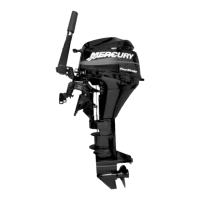10
90-10185R30
GB
ob
GENERAL INFORMATION
obk1
SAFE BOATING SUGGESTIONS
In order to safely enjoy the waterways, familiarize yourself with local and other
governmental boating regulations and restrictions, and consider the following
suggestions.
Use flotation devices. Have an approved personal flotation device of suitable
size for each person aboard (it is the law) and have it readily accessible.
Do not overload your boat. Most boats are rated and certified for maximum load
(weight) capacities (refer to your boat capacity plate). If in doubt, contact your
dealer or the boats manufacturer.
Perform safety checks and required maintenance. Follow a regular schedule
and ensure that all repairs are properly made.
Know and obey all nautical rules and laws of the waterways. Boat operators
should complete a boating safety course. Courses are offered in the U.S.A. by (1)
The U.S. Coast Guard Auxiliary, (2) The Power Squadron, (3) The Red Cross and
(4) your state boating law enforcement agency. Inquiries may be made to the
Boating Hot-line, 1-800-368-5647 or the Boat U.S. Foundation information number
1-800-336-BOAT.
Make sure everyone in the boat is properly seated. Don’t allow anyone to sit
or ride on any part of the boat that was not intended for such use. This includes
backs of seats, gunwales, transom, bow, decks, raised fishing seats, any rotating
fishing seat; anywhere that sudden unexpected acceleration, sudden stopping,
unexpected loss of boat control or sudden boat movement could cause a person
to be thrown overboard or into the boat.
Never be under the influence of alcohol or drugs while boating (it is the law).
They impair your judgment and greatly reduce your ability to react quickly.
Prepare other boat operators. Instruct at least one person on board in the basics
of starting and operating the outboard and boat handling in case the driver
becomes disabled or falls overboard.
Passenger boarding. Stop the engine whenever passengers are boarding,
unloading or are near the back (stern) of the boat. Just shifting the outboard into
neutral is not sufficient.
Be alert. The operator of the boat is responsible by law to “maintain a proper
lookout by sight (and hearing).” The operator must have an unobstructed view
particularly to the front. No passengers, load, or fishing seats should block the
operators view when operating the boat above idle speed.
Never drive your boat directly behind a water skier in case the skier falls.
As an example, your boat traveling at 25 miles per hour (40 km/hr) in 5 seconds
will overtake a fallen skier who was 200 feet (61m) in front of you.
Watch fallen skiers. When using your boat for water skiing or similar activities,
always keep a fallen or down skier on the operator’s side of the boat while returning
to attend the skier. The operator should always have the down skier in sight and
never back up to the skier or anyone in the water.
Report accidents. Boat operators are required by law to file a Boating Accident
Report with their state boating law enforcement agency when their boat is involved
in certain boating accidents. A boating accident must be reported if (1) there is loss
of life or probable loss of life, (2) there is personal injury requiring medical treatment
beyond first aid, (3) there is damage to boats or other property where the damage
value exceeds $500.00 or (4) there is complete loss of the boat. Seek further
assistance from local law enforcement.
gob21
19XX
XX
OGXXXXXX
XXXX
a
c
b
d
e
obl9
RECORDING SERIAL NUMBER
It is important to record this number for future reference. The serial number is
located on the outboard as shown.3
a. Serial Number
b. Model Year
c. Model Designation
d. Year Manufactured
e. Certified Europe Insignia (as Applicable)
obm90
SPECIFICATIONS
Models 8.0 9.9 15
Horsepower 8.0 9.9 15
Kilowatts 5.9 7.4 11.2
Engine Type 4-Stroke
Number of Cylinders 2
Full Throttle RPM Range 4500-5500 RPM
Idle Speed in Forward Gear 800-900 RPM
Piston Displacement 323 cm
3
Cylinder Bore 59 mm
Piston Stroke 59 mm
Valve Clearance (Cold)
Intake Valve
Exhaust Valve
0.15-0.25 mm
0.20-0.30 mm)
Recommended Spark Plug NGK DPR6EA-9
Spark Plug Gap 1.0 mm
Gear Ratio
Standard Models
Bigfoot Models
2.0:1
2.42:1
Recommended Gasoline Refer to Fuel Section
Recommended Oil Refer to Fuel Section
Gear Case Lubricant Capacity
Standard Models
Bigfoot Models
200 ml
260 ml
Engine Oil Capacity 1 Liter
Battery Rating 465 Marine Cranking Amps (MCA)
or 350 Cold Cranking Amps (CCA)
Sound at Drivers Ear (ICOMIA 39–94) 8.0 9.9 15
4-stroke – – 82.1
4-stroke with tiller – 78 82.7
gob22
12
4
3
0-1 in.
(0-25mm)
a
c
b
a
0–25 mm
ob
INSTALLATION
oca2
INSTALLING OUTBOARD
Note: If your outboard is a remote control electric start model, follow instructions
in the outboard installation manual (provided with the outboard) for installing
remote steering, shift and throttle cables and remote wiring harness.
Boat Transom Height Requirement
1 Measure the transom height of your boat. The boat bottom should be aligned
or be within 1 in. (25mm) above the anti-ventilation plate (a) of the outboard.
Installing Outboard on Transom
2 Place outboard on center line of transom.
3 Tighten transom clamp handles.
4 To prevent loss of outboard overboard, fasten outboard by drill-ing two 5/16 in.
(7.9 mm) holes through the transom using transom clamp holes as a template.
Fasten with two bolts (a), flat washers (b) and locknuts (c). Use a marine
waterproofing sealer in holes and around bolts to make the installation water
tight.

